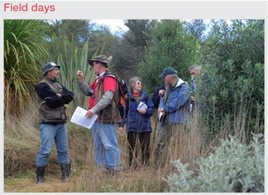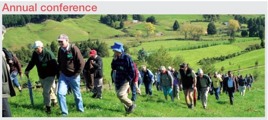Using a portable sawmilling service
John and Ben Bergman, New Zealand Tree Grower May 2013.
Mahoe Sawmills design and manufacture a range of portable sawmills from the factory in Kerikeri. The first machines were made after a delegation of Russians visited the family farm to see the Mahoe cheese factory and ordered two sawmills on the spot. We had previous experience milling and retailing, specialising in salvage kauri and furniture making, and this background gave us the edge for designing a portable sawmill.
Our customers are a diverse lot. Many farmers invest in a sawmill to process their logs. Firewood merchants like the option of timber or firewood from the logs, and sawmill contractors buy native logs or plantation trees to mill and sell the timber or contract cut for the owners.
There are many advantages in using a portable sawmill. Milling on-site reduces trucking costs, with the packets of timber taking up less space than logs. Portable sawmills with a slabbing attachment can cut a large variety of sizes. Production can also be increased easily by adding another sawmill.
Reasons to plant
It is wonderful to see the trees that you have planted grow. The longer you leave them the better they get, and with some pruning and thinning a nice little forest can develop. Planting trees on the less desirable farming land makes sense. This is whether you have concentrated on large areas of steep and inaccessible land and planted it in pine, adding value with regular pruning and thinning, just left it to grow, or you have smaller areas of higher value trees.
Macrocarpa has been popular with a future in supplying the furniture, flooring and popular eco market. Eucalypt varieties abound, and if the right ones have been planted there is a healthy demand for flooring and decking. Finding a tree that suits your area is good if it gives value financially, provides shade or helps ground stability. Replanting native species is not for immediate return, but gives a great deal of pleasure to watch grow and for grandchildren to admire.
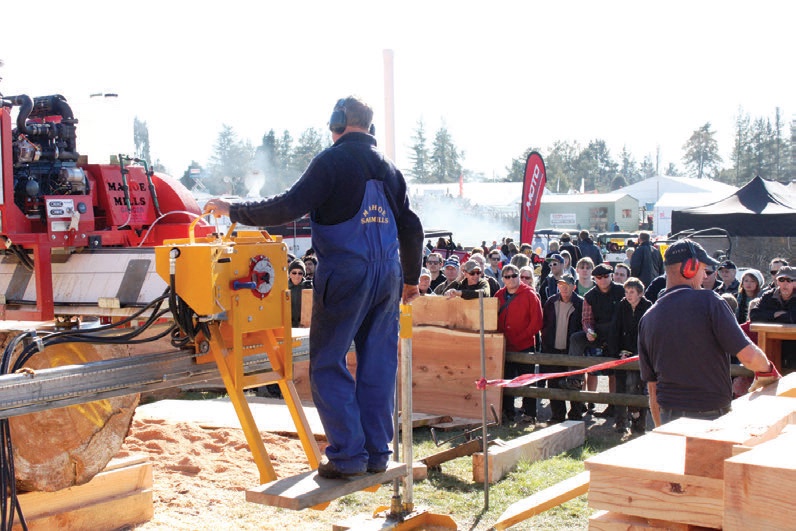
There are many reasons to plant forestry blocks, and not all of them are about financial gain. They require a great deal of work and money to get established and need time to mature. You can expect to get a return on your investment, but there are other values attached to farm forestry blocks. Stock can graze under maturing trees which provide valuable shelter. Companion planting adds interest, value and aesthetics to a varied species forest. Manuka regeneration, or using existing manuka for nursing trees, encourages length not branches.
A farm forester can have many reasons to plant trees, but the eventual end to the process is usually removing the trees. Pine can be harvested before maturity. This can be an advantage in helping you decide on the harvest time, depending on current log prices. Generally, farm foresters want a financial reward for their efforts.
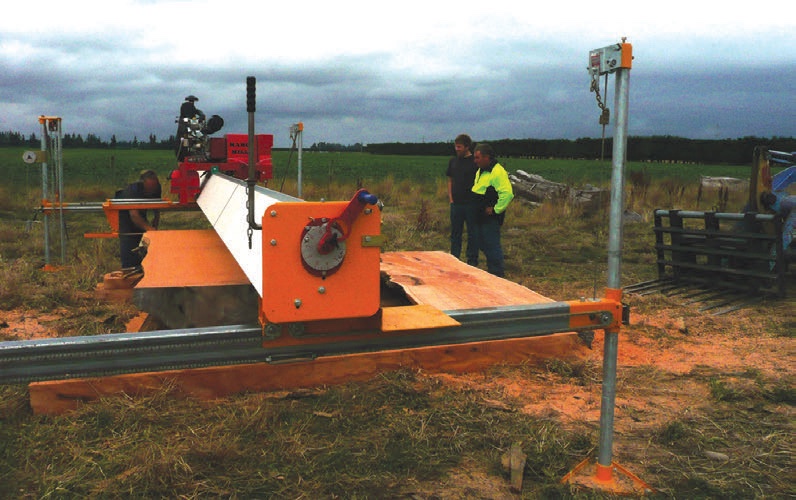
The best profit?
Thinnings may be made into poles or chips, but this is not usually where the best returns are found. These come at the end of the process when you harvest mature trees. Radiata pine is the most planted species, so the disadvantage is that they are competing with large forest plantations and corporate sawmills. Logging gangs are set up to harvest hectares of plantation pine, with millions of dollars invested in sky haulers, harvesting heads, diggers, loaders and trucks.
We hear sad stories of owners of smaller blocks owing money after having their small forestry areas harvested. A log buyer can buy your trees and offset their value against the cost of harvesting, a system which works well for big plantations. But if your forest is remote and spread out in smaller blocks over a large area, on steep difficult terrain, or a long way from the port or sawmill, then the log buyer or logging or trucking company may be the only person making any money.
This is why a popular option for farm foresters is harvesting your own timber. Often a mill is purchased before the plantation is fully mature.Wind-blown and damaged trees can be processed and farm projects completed without having to buy timber. Pine can be milled, dried and treated to then be used for fencing or new farm buildings, reducing costs and using the farmer’s resources.
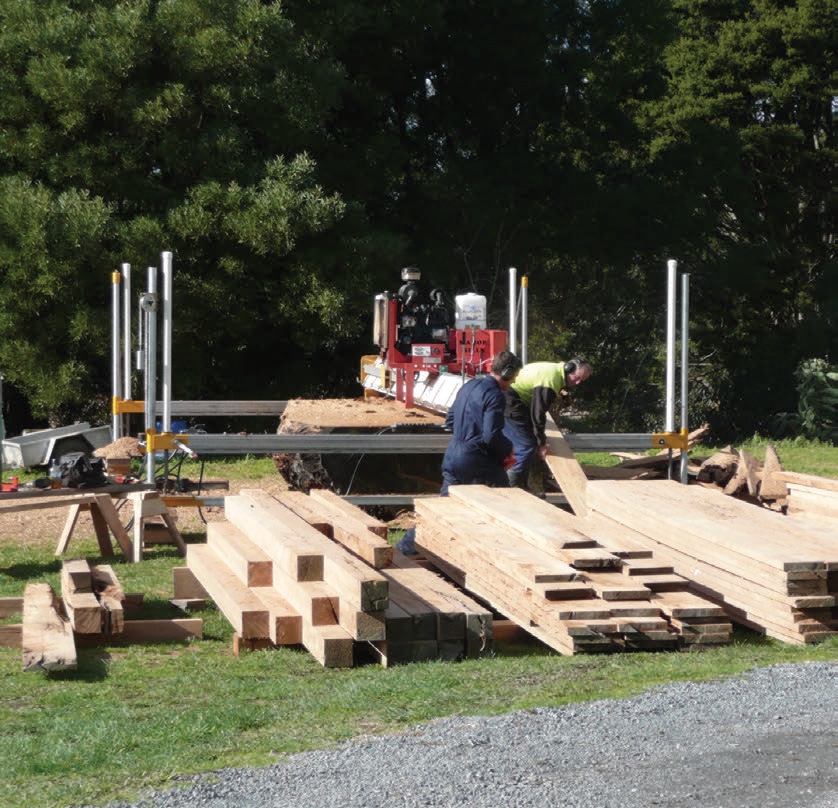
Which portable mill to buy
The most suitable portable mill is a twin saw or swing-blade sawmill. The old breakdown sawmills were very popular 50 years ago, but are less popular now and not available new. Bandsaws are also available, but are not as popular in this country. The New Zealand grown trees are generally harder, with knots and branches, making it difficult for the bands to track through the logs to produce accurate boards. Bandsaws are more suitable to break down flitches when the bark is removed.
Deciding which mill to buy takes time and research. Your decision will be made by knowing what you want from the sawmill, and what you are expecting to achieve. Questions to be asked include –
- Are you going to be moving the sawmill around or will it be in one fixed position?
- Will electricity be available to the site or will the sawmill need to have a petrol or diesel motor?
- If the sawmill is to be moved from site-to-site, will the terrain affect the ease of setting it up?
- What size logs will be cut, and will the logs fit into the mill?
- What size boards are you expecting to cut and what will they be for?
- Do you want to cut larger sizes to be broken down later, or sleepers out of second grade logs not suitable to retrieve clear boards from?
- Do you want to slab any of your logs, and if so do you need a dedicated slabber or an attachment to use your existing equipment?
- Do you want to use every bit of timber possible, for example, will fillets and fence battens be part of your cutting list?
- Will you need to cut to the taper of the log to gain the best wood from the outside of your logs?
When you are buying a sawmill you need all these questions to be answered before you part with any money. Check on the reliability of the sawmill, the back-up service, safety, availability of spare parts and practical experience of sawmilling from the manufacturer. Sometimes the sawmill manufacturers can help with your timber sales.
Less accessible terrain
Many farm forestry blocks are on steep inaccessible terrain. How can you reap the benefits of investment when everything seems difficult? When growing pine, if you do not cut it down this year, then next year it will be a little bit bigger. Therefore you should only cut down what you can manage to mill.
If you only cut a truckload of timber a day you can bring it home with you, reducing expensive trucking costs. It is always a good idea to stack your timber to air-dry close to a good all-weather road. When it is ready to send away you will not be held up by bad weather affecting the roads. The farm tractor with a trailer is also a good option.
Over the summer the logs and cut timber will sap-stain – it is worse in these months. If the weather stops the work it puts pressure on the portable sawmiller to get it milled quickly when the opportunity arises. After the boards have come off the mill, it is best to fillet the timber immediately and air-dry as quickly as possible. If conditions are right, this can eliminate the need to do anti-sap-stain treatment.
One or more milling sites
One large milling site is often the preferred option when harvesting a block. Everything can be all together with the sawmill in the middle, the log stacks at one end and timber ready to be trucked out at the other end. This requires a reasonable amount of room, which in steep country can be difficult. Some mills require flat ground to be set up, and this is a factor to consider when purchasing your sawmill.
If your block is large, multiple sites are an option to decrease the distance the felled trees have to be taken to the mill site. A good loader is essential for moving logs and loading packets of timber on to trucks. For smaller blocks your farm tractor can be used for loading logs into the mill with cut timber stacked directly on to a trailer. With high value timber, heli-logging could be an option. This can be either flying the mill into the forest and the packets of timber out or flying the logs to a central mill site.
Big logging gangs often have to put in extra roading at harvesting time. For farm foresters harvesting their own block there are other options. New roading can be beneficial but expensive. If this is not possible, consider using your existing tracks and making smaller milling sites.
Harvesting
Once you have access sorted out, the next step is cutting the trees down. This task is one of the most dangerous parts of forestry. It is recommended that you only employ knowledgeable personnel to harvest the trees or oversee the job. Qualifications can be obtained and training given at Rotorua or various other educational institutes.
Logs are best when they have not been in contact with the ground as mud and stones blunt the saw blades. A loader is best, but often a bulldozer and winch can be used to move the logs.
Getting the best from your logs will give you the most return. Second grade logs can go for pulp. The better logs should be milled and cut timber sold. There is very little good quality pine available on the domestic market and smaller wholesalers may be interested in buying premium quality pine.
Pine has to be air-dried and treated before it is saleable, so your options are to sell the cut timber green off the saw or have it processed yourself. This will involve air-drying the pine block, stacking the timber and trucking it to the treatment plant, then having it treated and trucked to its destination.
Getting the best from the mill
Milling the timber yourself is very rewarding. Watching the finished boards being returned and seeing the quality of the timber that you have grown is very satisfying. But how do you know how to get the best out of your logs?
Pruned logs will give you the most clearwood, but this can also be found in plantations which have not been pruned. Finding it can be the problem. Cutting to taper and being able to move the mill up and down in the logs will give you the ability to hunt the clear wood and not leave it to luck. The Mahoe Supermill will maximise your quality of cut. Cutting patterns will vary from between mills and from log- to-log.
Farm foresters will want to get the best from their logs and will quickly learn how cutting patterns can increase the financial gain.
- The top comes off the log first
- On the second drop down the log, the first saleable boards are retrieved and a 300 mm drop will open up the side of the log and give a good sight of what is inside
- From here the sawmiller can decide their next cut
- The hydraulics let you go back up to cut to another board and will accurately bring you down again to finish the row at 300 mm
- The best wood is closest to the outside and straight- grained to give maximum strength.
- Both the Mahoe Supermill and Minimax cut to taper.
This lets you line the mill up to the first side of the log and cut full-length boards, and when you get to the pruning knots or second grade core wood you can cut a tapered board. This brings you back to full length, straight-grained boards from the second side of the log.
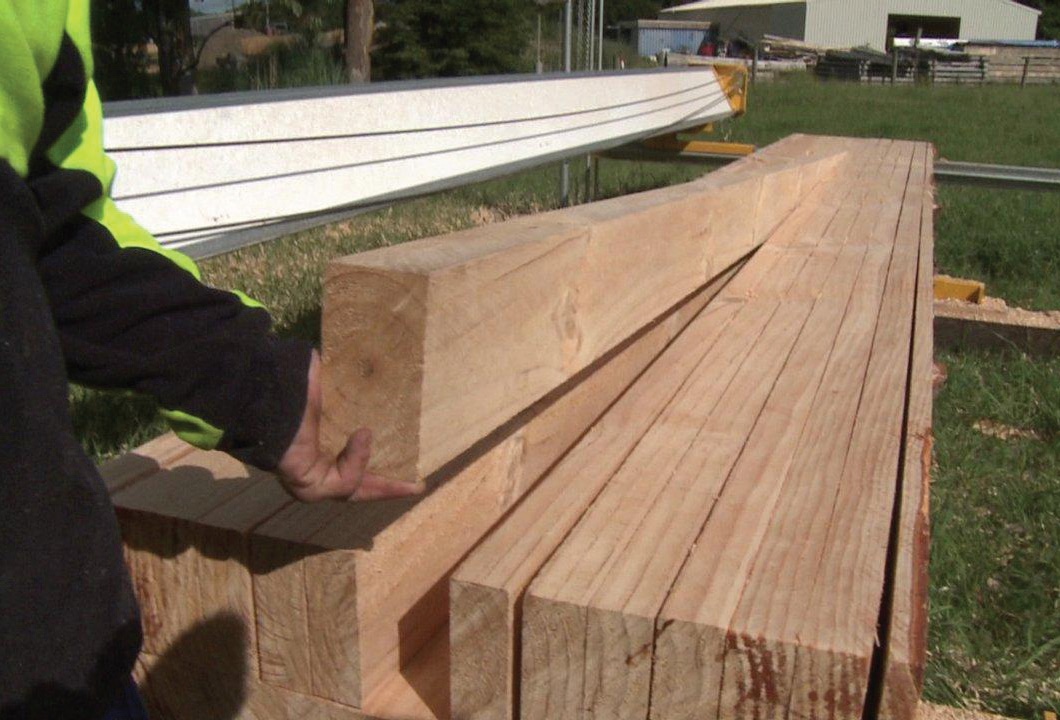
You can sight down a log, and if you see clear wood can hunt it out with the cut to taper. Many sawmillers cutting native timbers will only use mills with cut to taper to maximise their returns by milling for the valued heart and coloured grades.
Blade maintenance
Keeping your saw blades sharp is an important part of the operation. Timber loses value, and the sawmillers loses credibility, if boards are not accurate. Select a sawmill blade to suit your cutting requirements. Fine kerf blades are most suitable for milling good quality logs and are ideal for smaller cuts. For larger cuts, the standard weld-on tipped blades are ideal. The weld on tipped blades are sent away to be re-tipped, but are sharpened on-site.
The inserted tooth blades are very robust and reliable and ideal for logs with defects, knots and branches. They can be sharpened on-site and you can also replace the worn out or damaged teeth yourself on-site. Some mills supply a sharpener which allows you to sharpen the blades while they are still on the mill. The best sharpener will swipe each tooth at the same angle, keeping all teeth aligned. It is important that one tooth is not protruding as this will scour the board and not leave a good finish.
When your saw teeth are very sharp and your blades aligned, the mill is robust without wobble or twist. This means you will get a fine quality finish on your boards and the most accurate timber. Using cut to taper you can get the strongest boards with straight-grain. It is in the interest of a farmer or portable sawmiller buying logs to get the best recovery from their trees and a portable sawmill will help achieve this.
John and Ben Bergman are the General Managers of Mahoe Sawmills in Kerikeri.

 Farm Forestry New Zealand
Farm Forestry New Zealand
